Make this filling, delicious Split Pea and Ham Soup on a cold day to warm you up! Recipe also includes tutorial for canning this soup for long term storage!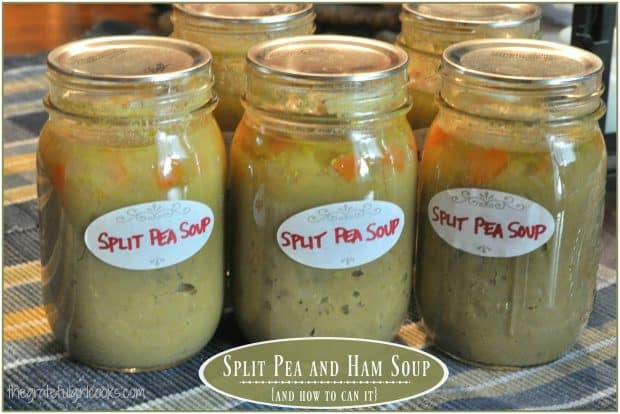
Last week I decided to can some Split Pea and Ham Soup to store in our pantry for the cold Fall and Winter months ahead. It’s always satisfying to pull out a homemade “bone-warming” hearty soup out of our pantry when it’s cold and stormy outside!
Guess what? Even if you don’t can jars of food, this is a delicious, easy, and economical soup to prepare for your family! This recipe makes a big pot of split pea and ham soup.
Scroll Down For A Printable Recipe Card At the Bottom Of The Page
How To Make Split Pea And Ham Soup
Combine 2 cups of split peas (a one pound bag) with water in a large soup pot. I used water PLUS added 2 large chicken bouillon cubes for flavor. Cook the split peas on medium-low for about an hour, just until they become tender.
Puree The Cooked Split Peas
Use an immersion blender to completely blend the peas until smooth. I puréed the peas until smooth, but it’s okay to leave them a bit chunky, if that’s how you enjoy them. NOTE: You can also process the peas and liquid in a food processor or blender. If using these appliances, work in batches, a little at a time, until puréed.
Make The Split Pea And Ham Soup
Add the carrots, ham, onion, bay leaf, and allspice to the puréed pea mixture in soup pot.
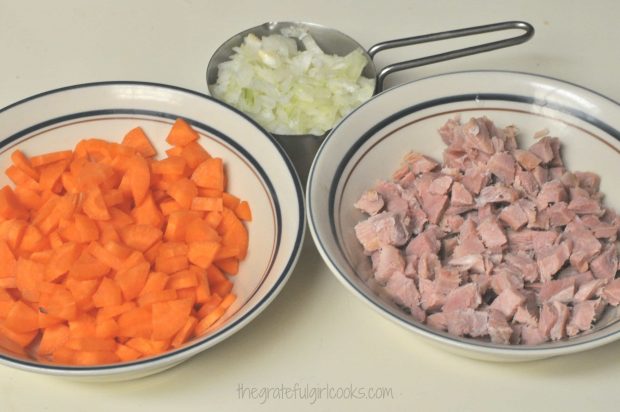
Bring the split pea and ham soup to a boil using medium-high heat. Once the soup is boiling, reduce heat to low. Cook the soup on reduced heat for about 30 minutes. If the soup gets too thick, you can add a little bit more boiling water.
Once fully cooked, the split pea and ham soup will be ready to eat (if NOT canning).
How To Can Split Pea And Ham Soup
If canning, while soup is cooking, prepare pressure canner, canning jars and flat lids per manufacturer instructions (for cleaning, heating, etc.). Typically I put clean canning jars on a dish towel lined baking sheet. Let the jars heat in a 225 degree oven for about 20 minutes before filling.
Ladle the hot split pea and ham soup into prepared hot jars. Leave 1 inch headspace in each jar. The soup will thicken during the canning process, by the way!
Remove air bubbles from each jar, and make sure you have the correct headspace. Adjust the headspace, if necessary, by removing or adding liquid. Wipe rims of each jar clean with a wet paper towel to ensure a proper seal. Place a prepared flat lid on each jar, then tighten the screw band on, to fingertip tightness.
Carefully place the prepared jars of soup into the prepared pressure canner using canning tongs. Lock the lid, and process, according to manufacturer and USDA instructions for YOUR specific pressure canner. Example: Bring to boil, vent steam for 10 minutes, close vent, etc..
How Long To Process The Split Pea and Ham Soup In Pressure Canner
Process jars of soup at 10 pounds pressure. Pint jars are processed for 75 minutes and Quart jars are processed for 90 minutes.
When processing time is done, turn the heat off. Let the pressure in your canner drop to zero on it’s own. Wait a couple additional minutes, then open vent. Let canner sit for an additional 10 minutes once vent is open. Carefully remove lid, then remove jars, using canning tongs.
Place the hot jars of split pea and ham soup onto a dish towel. Do NOT set jars directly onto kitchen counter, because the extremely hot jars could crack, because of temperature variations. Let the hot jars cool undisturbed, for 24 hours, then label the jars of soup, and store in your pantry.
This recipe (from one of myBall canning books), makes 5 pint sized jars or 2 quart sized jars of split pea and ham soup. I made 5 pint jars this time, and now they are happily shelved in our pantry for a “rainy” day!
Canned split pea and ham soup tends to thicken quite a bit during the processing. When you open a jar, simply add a little bit of hot water to the soup. Heat soup until hot, and serve! It’s delicious!
It’s very fulfilling to prepare canned foods to stock our pantry with foods like this split pea and ham soup! I hope you enjoy the canning process, as well as this wonderful tasting soup! Have a great day!
Looking For Other Canning Recipes On This Blog?
You can find my canning recipes in the Recipe Index in the top Menu Bar at the top of each blog post. Some of my canning recipes include:
- Apple Butter
- Bread and Butter Pickles
- Ham and Bean Soup
- Green Beans
- Dried Beans (pinto/black/garbanzo, etc.)
I have many more canning recipes, including lots of Jam recipes, too! Hope you will check them out in my Recipe Index!
Interested In More Recipes?
Thank you for visiting this website. I appreciate you using some of your valuable time to do so. If you’re interested, I publish a newsletter 2 times per month (1st and 15th) with all the latest recipes, and other fun info. I would be honored to have you join our growing list of subscribers, so you never miss a great recipe!
There is a Newsletter subscription box on the top right side (or bottom) of each blog post, depending on the device you use, where you can easily submit your e-mail address (only) to be included in my mailing list.
You Can Also Find Me On Social Media:
Facebook page: The Grateful Girl Cooks!
Pinterest: The Grateful Girl Cooks!
Instagram: jbatthegratefulgirlcooks
Recipe Source: My book called “Ball Complete Book of Home Preserving”, Published 2012, Robert Rose, Inc., page 403.

- 2 cups dried split peas
- 8 cups water
- 2 large chicken bouillon cubes (optional, but adds additional flavor to broth)
- 1 cup diced ham
- 1 ½ cups sliced carrots
- 1 cup chopped onion
- ¼ teaspoon ground allspice
- 1 bay leaf
- Salt and Pepper , to taste
- Place split peas, water and chicken bouillon cubes into a large saucepan or soup pot (stainless steel is best). Bring the ingredients to a boil with medium-high heat, stirring occasionally. Once they come to a boil, turn down the heat to a low simmer; let the peas continue to cook for about an hour (or until the split peas become tender).
- When peas are done, purée peas and liquid, using a stick immersion blender OR processing in batches using a food processor. If using food processor, return purée to pan.
- Prepare pressure canner, jars, lids, etc. per manufacturer guidelines.
- Add ham, carrots, onion, allspice and bay leaf to soup. Bring soup to a boil. Reduce heat to low and cook for 30 minutes. Season soup with salt and pepper, to taste. If soup is a bit too thick, you can thin it out a little by adding a bit of boiling water to pan. Stir to combine. Remove bay leaf.
- Place hot, prepared jars on a dish towel. Ladle the soup mixture into jars, being sure to leave 1 inch headspace on each jar. Remove or add liquid, as necessary, to ensure correct headspace. Remove air bubbles from jars, then wipe the rim of jars clean using a wet paper towel, to ensure a good seal. Place hot flat lids on jar, then screw the bands into place until they are fingertip tight.
- Carefully put the jars into water in prepared pressure canner. Lock lid; turn heat to medium-high. Once vent begins steaming, let it vent for 10 minutes, then close vent. Heat until canner reaches 10 pounds pressure. After it reaches 10 pounds pressure, process PINTS for 75 minutes and QUARTS for 90 minutes.
- When done, turn off heat. Let the pressure in the canner drop to zero naturally. Once it gets to zero, wait a couple more minutes, then open the vent cover. Wait another 10 minutes, then carefully remove the canner lid. Place the hot jars on a dish towel on counter, and let them sit undisturbed for 24 hours. Check for proper seal, then label and store jars in pantry.
If using quart sized jars, this recipe will make 2 quarts (plus a bit more). The recipe is easily doubled.
When you open a can, you will notice that the soup will have thickened slightly during the canning process. Just add a bit of water to soup, reheat and enjoy!
Here’s one more to pin on your Pinterest boards!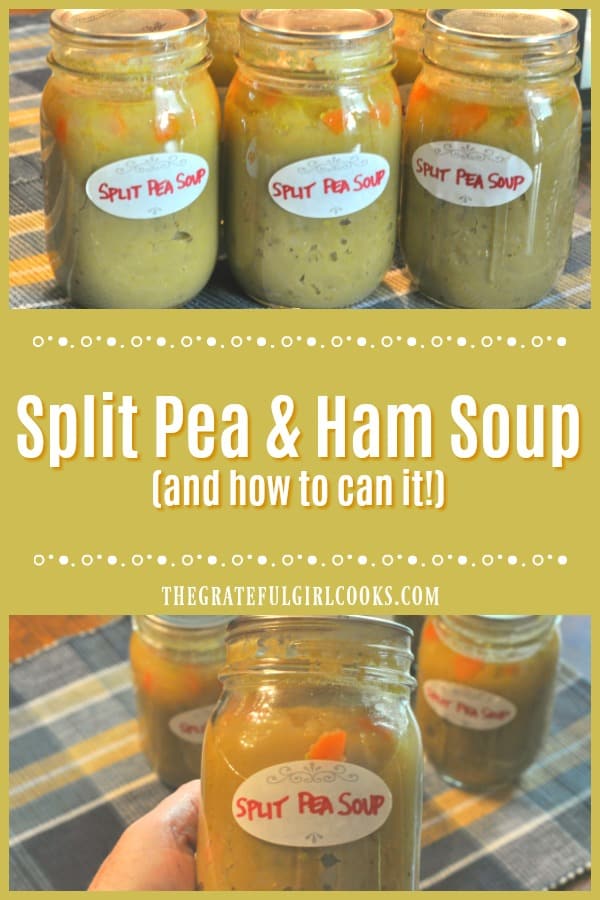

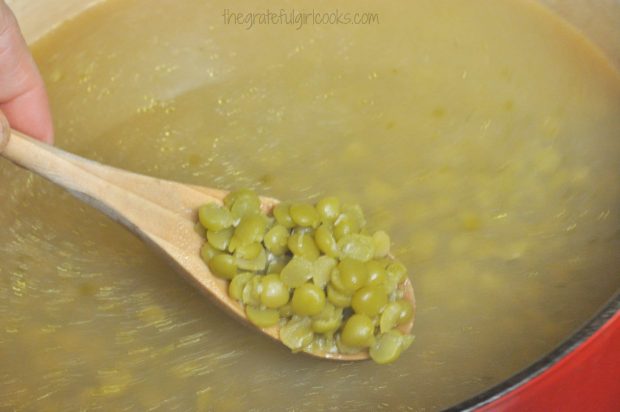


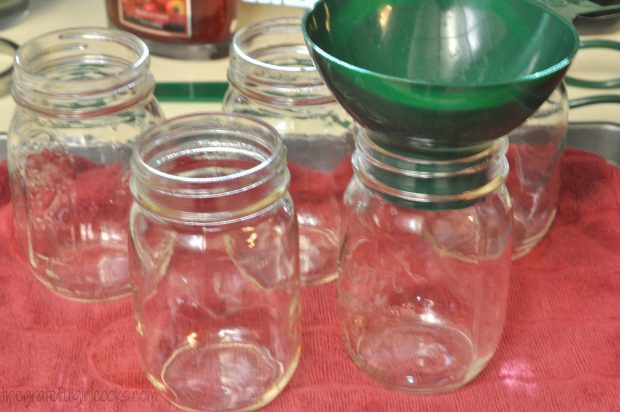

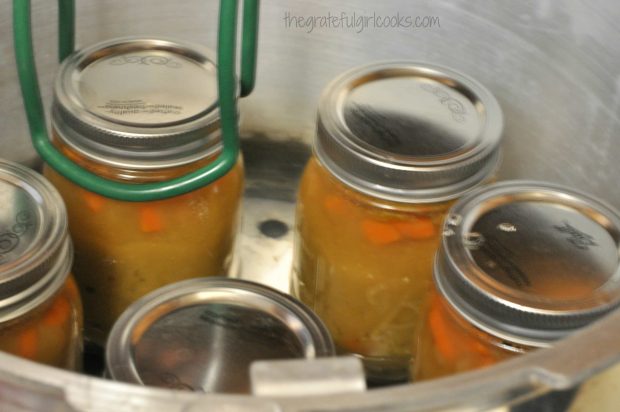



This split pea and ham soup recipe is our go-to for utilizing leftover ham bones and meat. We’ve prepared it twice already, and I’m currently making it again. I’ve got my large stock pot simmering on the stove, using six bags (1 pound each) of split peas. I also added two ham bones and some leftover ham, along with a bit of the canned turkey broth we made last month. The aroma wafting through the house is absolutely delightful right now.
Thanks for your note, Nicole! So glad you enjoy this soup. I just canned some more of the soup 3 weeks ago, just in time for wintertime COLD weather!
We just canned it up ourselves and got 17 pints and 4 quarts, plus extra for lunch and dinner set aside. Now we have more jars on the shelf for winter.
Canned this last year and pulled it out tonight for dinner. Absolutely deeeeelish!!! It is so good and I’m about to can a whole bunch more. Up here in Montana we are headed into winter and this is the perfect dinner on a cold night! ❤️❤️
I can’t wait to CAN your soup recipe this week. IT IS EXCELLENT! Your upbeat attitude and answers just motivated me!
And, by the way, I admire you for admitting it when you are not sure about a question. I feel more confident with your advice. Keep it coming!
Thank you for your kind note, Jeanne. I hope you have great success canning this delicious soup. Guess what? This soup is already on my TO DO list for this week, as well! Have a wonderful day.
Fantastic soup! Was my first time pressure canning and everything worked out perfectly!
Hubby said he would definitely eat this again!
Wonderful, Pamela! I am so glad for your success with pressure canning this soup! Thanks for your note… and Happy New Year!
Hi J B. Thank you for the wonderful split pea and ham soup recipe. I’ve had my canner since a year ago Christmas. I was so nervous to try. Well, thanks to you I did it. I followed your recipe , actually doubling it and had 5 quarts made to put up. It was delicious!! I loved hearing the popping as the seals were made. I was so excited!!! Thank you. I am now a canner!!
Question, I followed your recipe and it tastes wonderful but there is a little dark green spots on the top, concerned it may be mold, processed for the correct time and pressure, tops are sealed tight. Have you see. This before, someone told me it’s normal, could be fat or residue from skins.
I was wondering if a water bath of hot boiling water to pressurize the canning method !?
I do not own a pressure cooker .
Hi, Stephanie- Unfortunately this soup MUST be canned using a pressure canner. Water bath canning does not allow the soup to be heated to a temperature hot enough to kill off potential harmful bacteria in this (long term storage) pantry stable product. It is not safe to can this using a water bath. Sorry.
Hi,tried your recipe for pea soup yesterday and it came out great – thanks for your wonderful tutorial. I have a question … I know you said the soup would thicken once canned, but mine has REALLY thickened to almost a solid state. Based on your pics I think it was probably a little thicker when going into the jars than your’s. I used chicken broth instead of water and I did not puree. Do you think it’s safe or did I do something that could be potentially harmful? Thanks for your time!
I would think it is fine, if you processed it according to directions for pounds of pressure and length of time to safely process it. If it is still too thick when you open a jar, simply add a bit of water (or more chicken broth) to the soup to thin it out before reheating. I usually do this, too. Have a great day.
Hello, I am new to pressure cooker canning. I make a split pea soup but I add potatoes and I’m wondering with your recipe if I am able to add potatoes to the split pea soup recipe? Thank you in advance.
Hi, Florence… I have not tried this recipe adding any other ingredients except what are in the printed recipe. I’m sorry I don’t know enough about that to be helpful.
What is your elevation? Should the pressure be adjusted for high elevations? I am at above 4,000ft and am not sure if 10lbs pressure would be the same. Thank you for the recipe!
Just now seeing this… I am just above sea level, so had to look up the answer to your question, Jessica. In researching in my Ball Canning Book that I got the recipe from, it says you should process for the same amount of time, but at a 4,000-6000 feet elevation, you should process it a a higher level. A weighted gauge canner should be at 15 pounds pressure for this recipe, and a dial gauge canner should be set for 13 pounds pressure. Hope that helps.
Good Morning.
I am so excited to try this! It’s our first year doing this and love this idea of soup. How long does it last on the shelf? I’m sorry but i didn’t see this mentioned or misread 😀
Good morning, Michelle. Typically this type of soup is shelf stable for up to a year. I’ve even found a straggler jar about 15 months after canning, and it still tasted wonderful. This reminds me I need to make/can some more of this before winter! Have a great day!
From my experience it lasts longer than that. I’ve been canning for years and have many canned foods on hand. I opened my last jar that I canned over 4 years ago and it was just as delicious as the 1st one.
I am “new” and only use to WB processing. Why can’t some recipes, such as this split pea soup, be WB processed? Please understand this is not a challenge I am just trying to understand the why/why not
and convert as many things to WB as I can. I am not interested in purchasing a
pressure cooker. Thank you so much.
Good morning, Carolyn. Thank you for writing. I, by no means, am any kind of expert in canning, but I do know that pressure canning is used for meat, poultry, fish or non-acidic vegetables (which is in my recipe). To quote from my “Ball Complete Book Of Home Preserving”, page 380: “Low acid foods contain little natural acid.This is an important factor in preserving because acid guards against bacterial growth that is a risk for public health. If foods do not have enough natural acid, they must be heated to very high temperatures to be preserved safely. These high temperatures are essential when preserving low-acid foods so that all of the bacteria that can pose a danger to your health will be destroyed.”
is it possible to can this soup without a pressure canner
Hi, Diane. Unfortunately this recipe needs to be pressure canned.
I Just made this simple but very delicious and heart warming soup!
Thank you very much! Keep them coming! ?
Good afternoon, Esther! Thanks for your kind note, and I am really glad you enjoyed the soup. Take care, and have a great week.
Is it possible to just cook the split peas and can them without making soup? Then re-cooking to make soup later?
Also, can real bacon bits be used vs ham?
Hi there. Thank you for taking the time to write. I have never canned split peas by themselves, so not sure. I searched through all 5 of my canning books, and found no instructions for canning the split peas solely by themselves, so unfortunately I cannot answer your question. I have also never used real bacon bits as a substitute, so am not sure how that would impact the soup, besides requiring a large amount of bacon bits. Sorry I cannot be much more help to you. Take care.
Peas can, I have, be canned by themselves. Just use the same processing method as the soup requires using a pressure canner.